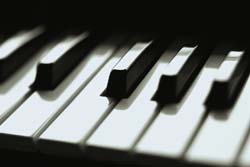
Home
- Artifacts
- Buildings & Businesses
- Churches
- Holidays & Celebrations
- Counties/Locations
- Delta College
- Early Settlers
- Ethnic Background
- Local, Michigan, U.S. and World Events
- Family Genealogy
- Farming
- Libraries & Museums
- Local Sites
- Logging
- Musicians, Artists & Famous People
- Nature, Weather & Four Seasons
- Railroads
- Schools
- Sports
It is the late 1800s and the city is Saginaw, Michigan. A young man, about the age of twenty-three, is sitting at a table in the Bordwell Opera House, sipping a glass of wine. It is around 7:05 P.M., and he notices the small brass band setting up in a corner.
"What are they doing over there?" he asks aloud, although there is nobody around to hear him. The man, we'll call him Herb, walks over to a table nearer to the crew setting up. Stroking his chin with his thumb and index finger, he asks a man setting up a drum set what is going on.
"It's time for a little entertainment around here. I'm here with a local band, and we're going to play a few dance numbers tonight," replies the dark-haired crewman, showing off his drumsticks to Herb. "Show starts at eight, hope to see you out there." He pats Herb on the back and goes about his business again. Herb strolls back to his seat and orders some more wine from one of the ladies passing by. He tells her that they will have to catch a dance later and winks and smiles at her.
At around eight, the band starts warming up and the noise level increases with anticipation. The smell of more expensive liquors becomes very tempting. Walter Bordwell, the opera house owner, got a good profit when there was a band in the building, and he made sure to make it worthwhile by serving only the best. The show ends around 9:30, and the attention is moved to a fight near the back of the bar. Herb goes home and gets a good night's rest, still humming a few bars from the performance. He enjoys music nights in Saginaw, because it really brings the town’s people--lumberjacks, barons and others--together and shows off the musicians in the Saginaw area.
Stuart Gross best describes the atmosphere of the Saginaw and Bay City area during the late 1800s, writing about what Herb (above) noticed. Some of the talents that Mr. Gross mentions are: musicians, circus acts, boxing, and daredevil stunts. He states:
* There was something magical in the air when timber was king. Maybe there was a virus in the sawdust that infected certain individuals with footlight fever. Whatever it was it was delightful, and for a few brief years the Saginaws and Bay City turned out an inordinate number of great artists that made it all the way to motion picture stardom and to the very peak of musical success. Despite the lurid reputations of the Catacombs, Bordwell's Opera House, and other so-called theaters attached to bigger saloons, these places were incubators for talent. (163)*
There were many musicians born, raised, or living in the Saginaw and Bay City areas during the time described above, people who became famous around the world. The ones featured in this paper include Charles K. Harris and Isham Jones, my favorite early musicians.
CHARLES K. HARRIS
In 1867, Charles K. Harris was born in Poughkeepsie, New York. The Harris family moved to Saginaw while he was still a young boy. He worked in a tailor shop that his father owned and later in the Bancroft Hotel as a bellboy. He met a lot of musicians during his time in the Bancroft (Smith 45). Later, he would go back to New York and eventually founded the Harris Music Publishing Company (Gross 167).
At a young age, Harris was working in the tailor shop and a few vaudeville performers came in and played some tunes. According to his biography in The Saginaw Hall of Fame, he "watched every move and then cobbled together a banjo from an empty oyster can, a broomstick and some strands of wire." He had a lot of success on his homemade instrument and, when he was about twelve and working at the Bancroft Hotel, a man staying in the hotel gave him a pass to see a performance at the Saginaw Academy of Music. Smith reports, "He [Harris] liked the show `better than Buffalo Bill.’” On another occasion, Harris was playing his homemade banjo, and another man staying at the hotel watched in amazement, and then gave Harris his real banjo. He loved it dearly and this sparked the rest of his music career. He got "a high degree of skill" and in a matter of time, he was "Professor Charles K. Harris, Banjoist and Song Writer," though he never actually learned to read music. He did everything by ear and "the black keys of a piano" (Smith 45). I know people like that. They are amazing to watch, so I can identify with how the public must have been in awe of his musical talent.
Aside from composing many songs, such as "After the Ball" (his most famous work), "When Did You Write To Mother Last," "When Angels Weep" (written in the midst of World War I), and "It's Not Always Bullets That Kill," Harris was also a fighter for the rights of music. "He was deeply concerned about protecting the rights of songwriters, and he was one of the founding fathers of the American Society of Composers, Authors, and Publishers (ASCAP)" and copyright laws were passed because he made a visit to President Theodore Roosevelt, personally (Smith 45).
ISHAM JONES
Another great musician at the time was Isham Jones. Jones was born on January 31, 1894, in  Coalton, Ohio. He came from a musical family, his father being in high demand for playing at weddings and many other events. In 1900, he moved to Saginaw with his family. Coal mining also seems to run in the family. He worked in a Saginaw coal mine during his teenage years and his father was a coal miner in Coalton. Isham's father worked in the Saginaw mines until the call of music grew louder than the pounding of the mining tools. Isham's father became a teacher of instrumental music, and then "a manager and leader of his own band" (Miller and Beach 47).
Coalton, Ohio. He came from a musical family, his father being in high demand for playing at weddings and many other events. In 1900, he moved to Saginaw with his family. Coal mining also seems to run in the family. He worked in a Saginaw coal mine during his teenage years and his father was a coal miner in Coalton. Isham's father worked in the Saginaw mines until the call of music grew louder than the pounding of the mining tools. Isham's father became a teacher of instrumental music, and then "a manager and leader of his own band" (Miller and Beach 47).
Isham, on the other hand, worked driving mules and hauling coal cars. He had bad pay and worked very long hours. When he was seventeen, he was watching entertainers at the Jeffers-Strand vaudeville theater. He got a front row seat, right in front of the orchestra pit to study them. What he didn't know was that this night would be the beginning of his "national fame." The piano player for the show had a stroke and was carried from the pit. The show went on, but it was evident that the show was lacking. Before anybody knew what happened, Isham jumped into the pit and surprisingly saved the show. The Jeffers-Strand theater manager said afterwards, "That boy is the finest musician I have seen in years," and not long after, Isham started his own orchestra.
Jones left Saginaw later, in 1915, because (according to his friends) of an automobile accident with a passenger train. He and five of his friends were in the car. Two of them were killed, three injured. Jones got a broken leg. He went to Chicago and met up with Ole Olsen, who became his partner in music. The Saginaw Hall of Fame states that he took his band around the United States and Europe. "They were acclaimed as the spirit of the Roaring Twenties and the Jazz Age."
Jones had one final performance in Saginaw in 1936 at a fraternity dance. At the age of 63, Isham Jones died of cancer, leaving a wife, Marguerite, and son, David Richard. Some songs that he is remembered for include: "I'll See You in My Dreams" and "The Wooden Soldier and the China Doll." His wife said that "I'll See You in My Dreams" was his favorite composition.
Herb was also a fan of Harris and Jones. He wakes up the next morning in a very chipper mood. He reflects, again, on the previous night. He thinks about some other times when musicians passed through the great city of Saginaw. Saginaw was an incubator for talent. There were many brilliant musicians at that time that came out of the Saginaw area. Harris and Jones were merely two of them.
Works Cited
- Gross, Stuart. Frankie and the Barons. Fowlerville, MI: Wilderness Adventure Books. 1991.
- Miller, Ed and Jean R. Beach. The Saginaw Hall of Fame. Saginaw, MI: Saginaw Hall of Fame. 1989.
- Smith, R. Grant. From Saginaw Valley to Tin Pan Alley. Detroit, MI: Wayne State Univ. Press. 1998.
| The written and visual works in Mid-Michigan Remembers-Stories about Us were chosen on the basis of their quality, diversity, community interest and appeal. Views expressed do not necessarily reflect those of the College. This space is provided as a service by Delta College. |
